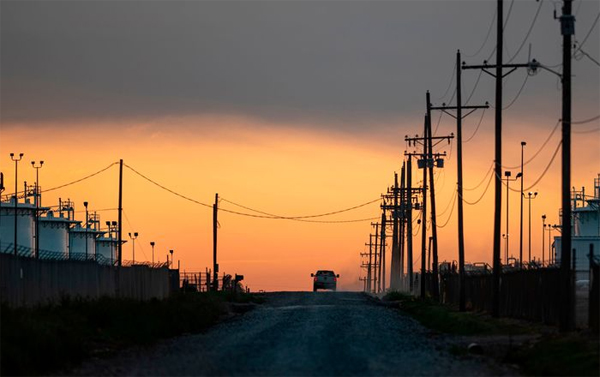Natural gas prices mixed as a near-term weather outlook shows warmer temps

Rachel Koning Beals, MarketWatch
CHICAGO
EnergiesNet.com 22 11 2022
Crude futures recovered Tuesday from the steep slump sparked Monday when markets digested mixed news that major producers were mulling churning out more oil.
Action was subdued with many beginning the holiday early. U.S. markets are closed Thursday for Thanksgiving and some will open for an abbreviated session Friday. Read more on market closings.
Energy-sector prices were generally weaker to start this week, but ended well off session lows Monday after Saudi Arabia’s energy minister denied a news report that the Organization of the Petroleum Exporting Countries and its allies were weighing a production increase. Such an increase would be seen helping to ease tensions with the U.S. and keep energy flowing as new efforts to curtail Russia’s oil industry take effect.
Crude has been under pressure on continued worries over China’s demand outlook in the face of renewed COVID-19 lockdowns.
Price action
- West Texas Intermediate crude for January CL00, 0.53% CLF23, 0.53% gained 91 cents per barrel, or 1.14%, to $80.95. The contract fell 7 cents to finish at $80.04 a barrel Monday after dropping more than 5% at its Monday session low. WTI hit an intraday low Monday not seen since January.
- January Brent crude BRN00, 0.57% BRNF23, 0.50%, the global benchmark, gained 91 cents, or 1%, at $88.36 a barrel. The contract lost 17 cents, or 0.2%, ending at $87.45 a barrel Monday. Both Brent and WTI saw their lowest finish Monday since late September.
- Back on Nymex, December gasoline RBZ22, -0.18% rose 4.3% to $2.5424 a gallon.
- December heating oil HOZ22, 0.92% rose initially but settled down 0.9% to $3.4653 a gallon.
- December natural gas NGZ22, 7.17% reversed its early course as well, down initially but closing up 0.04% at $6.7790 per million British thermal units.
Market driver
To start the week, both WTI and Brent briefly slumped to levels last seen in January after ending Friday at two-month lows. That drop came as The Wall Street Journal, citing unnamed delegates, first said Saudi Arabia and other producers from OPEC were discussing an output increase of as much as 500,000 barrels a day, likely announced at its early-December meeting.
A production increase is now under discussion for OPEC+’s Dec. 4 meeting, delegates said, according to the report. The move would come a day before the European Union is set to impose an embargo on Russian oil and the Group of Seven wealthiest nations’ plans to launch a price cap on Russian crude sales, potentially taking Moscow’s petroleum supplies off the market.
Any output increase would mark a partial reversal of a controversial decision last month to cut production by 2 million barrels a day.
Crude subsequently trimmed losses after additional news reports said Saudi Arabia’s energy minister told a state news agency that there had been no discussions of an output increase.
“Oil prices are trying to find a suitable center for gravity today,” said Stephen Innes, manager partner with SPI Asset Management. “Traders are trying to balance the 2-million-barrels-per-day output cuts announced in October, an imminent EU embargo on Russian oil shipments, and G-7 plans to set a price cap on Russian oil versus their ‘where there is smoke, there is fire’ [mentality] after reports that OPEC was considering increasing output.”
“A production increase amid falling prices and concerns about global demand would be a significant surprise,” Innes said.
OPEC+ agreed in October to cut output by 2 million barrels a day. The Commerzbank commodities team, writing in an early Tuesday note, said the cut will probably be more than 1 million barrels per day if all the countries whose production levels were recently in line with the agreement comply with the reduced production target applicable from November.
“This alone should be enough to roughly balance the oil market this quarter, meaning that the heavily depleted stocks will not be replenished,” they continued. “After another quarter in which supply and demand are likely to be more or less equal, the oil market risks being undersupplied from the second quarter of 2023 — a deficit that could even turn out to be sizable in the second half of 2023.”
On the demand side, focus remains on China and its latest COVID-19 developments. The southern Chinese city of Guangzhou on Monday locked down its largest district, suspending public transit and requiring residents to present a negative test if they want to leave their homes, the Associated Press reported.
“There was optimism that China, the world’s largest importer of oil, would introduce measures to bolster its economy, especially modifying the most stringent rules associated with its zero-COVID 19 policies,” said Quincy Krosby, chief global strategist for LPL Financial.
“As global central banks continue to raise interest rates, the slowing global economy — and possibility of recession — has also been a consistent concern that [oil] demand will substantially wane” Crosby said.
Natural-gas prices fell then gained Tuesday, choppy trading coming after gains in recent days following a historic snowstorm that hit New York state over the weekend.
NOAA’s 6-to-10-day outlook shows temperatures rising above normal for most of the central U.S., with colder temperatures only predicted for part of the Northeast, which may reduce heating demand in late November, analysts said. Still, the weather service’s updated 3- to 4-week outlook covering early-to-mid December indicated colder-than-normal conditions returning for nearly all the northern U.S., which could boost heating demand again.
marketwatch.com 11 22 2022












